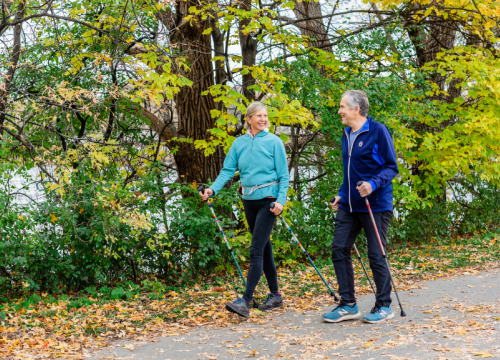Fall Prevention in Parkinson’s
Falls often become more common as Parkinson's disease (PD) progresses. Some falls cause only minor scrapes or bruises, but others can have a lasting impact on mobility and independence. Understanding how PD affects balance and taking steps to reduce your fall risk can help you stay safer and more independent.
Are you at risk for falling?
If you answer yes to any of the following questions, talk to your doctor.
- Have you fallen before?
- Are you afraid of falling?
- Do you tend to trip?
- Do you feel unsteady when walking?
- Do you experience freezing episodes?
- Do you ever feel dizzy or lightheaded after standing up?
- Do you take medications that may affect balance?
- If you rely on a mobility aid, like a walker, do you ever neglect to use it?
- Do you make nighttime bathroom visits?
Reasons for Falls in Parkinson’s
Parkinson's changes the way people move, which can affect balance, walking and posture, and may lead to falls. Since PD affects everyone differently, getting to know your own challenges can help you take steps to improve safety. Some common reasons for falls in PD include:
- Walking changes — Shorter, slower or shuffling steps can affect balance and increase the chance of tripping.
- Balance issues — PD can disrupt natural movements, posture and reflexes that help you stay steady and upright.
- Freezing — For some people with PD, it may feel like their feet are stuck to the floor, especially when passing through doorways, turning, feeling stressed or hurried or when medications wear off. Those who experience freezing are at a higher risk of falling.
- Low blood pressure — PD can affect the autonomic nervous system, which controls heart rate and blood flow. As a result, some people may experience a sudden drop in blood pressure when they stand up. This can cause dizziness, lightheadedness or tiredness, and increase the risk of falls.
- Medication side effects — Medications, including those prescribed for PD, can sometimes cause sleepiness and confusion, which can increase the risk of falling.
- Muscle weakness — PD symptoms can make it more difficult to stay active, which can weaken the muscles in your legs and core. This can affect your balance.
- Thinking changes — PD can affect focus, making multitasking even trickier. Walking while distracted can increase fall risk.
- Vision and perception issues — PD can cause blurry or double vision and difficulty judging distances, both of which can affect spatial awareness and balance. Though not directly linked to PD, hearing loss can also impact balance.
Strategies for Improving Balance and Reducing Falls
1. Talk to your healthcare team about fall risks.
Work to identify fall risks together, talking through issues that may lead to falls, like medication side effects, low blood pressure, thinking changes or freezing — and how to manage them.
2. Screen for hearing and vision changes.
Changes in hearing and vision can affect balance. Your doctor may refer you to specialists for evaluation if needed.
3. Stay active.
Exercise improves balance, mobility, strength and brain health, all of which can reduce fall risk. Ask your doctor for a referral to therapy.
Physical and occupational therapists help address fall risks through:
- Personalized exercises for balance and mobility.
- Strategies for managing PD challenges like freezing and short steps.
- Mobility aid suggestions like walking poles, canes or walkers.
- Home safety evaluations and modifications.
- Tips for making daily activities easier and safer.
4. Make your home safer.
Remove tripping hazards (clutter, loose rugs, cords). Install grab bars in the bathroom and add nightlights along the path to help you get there safely. Review our home safety checklist at Parkinson.org/HomeSafety.
What to Do After a Fall
1. Stay calm, check for injuries and call for help if needed.
2. Plan your moves before getting up.
3. If possible, crawl or scoot to a sturdy piece of furniture for support.
Tips for Safer Movement
- Move with care. Take your time when sitting, standing or turning.
- Improve balance. Widen your stance and take bigger steps.
- Arrange your space. Place everyday items within easy reach to avoid overreaching.
- Stay focused. Keep your hands free and concentrate on walking.
- Boost safety with technology. Use fall detection systems, such as medical alert devices or smart watches.


